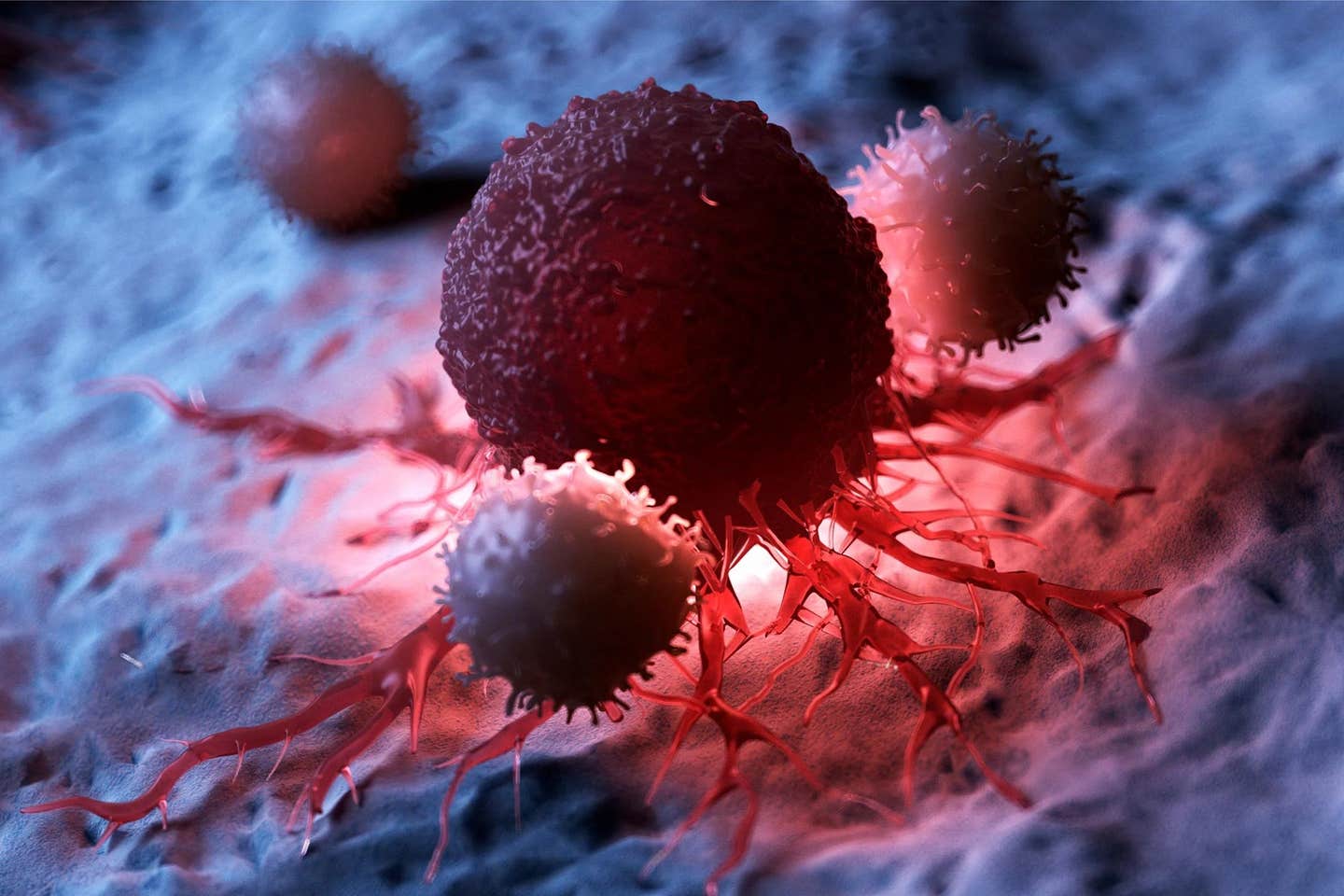Breakthrough antibody delivery system targets hidden cancer cells
Researchers in Japan built nanomachines using polyphenols and iron to deliver antibodies into cancer cells, shattering barriers to treatment.

 Edited By: Joseph Shavit
Edited By: Joseph Shavit

New nanocarriers use polyphenols and metal ions to deliver antibodies inside cancer cells, boosting tumor-fighting power. (CREDIT: Shutterstock)
In a groundbreaking leap forward for cancer therapy, scientists in Japan have created a tiny delivery system that helps powerful antibodies reach hidden targets deep inside cancer cells. These specially designed nanomachines may soon open the door to more precise, effective treatments for tough-to-treat tumors—without harming healthy tissue.
Antibodies are natural defenders produced by your immune system. They're shaped like the letter Y and attach to harmful invaders, like viruses or bacteria, to help remove them. Scientists have learned how to design these proteins to seek out cancer cells by locking onto unique markers on their surfaces. This has already helped many patients. But a huge roadblock remains: most dangerous cancer signals come from inside the cells, and antibodies struggle to get there.
Why Antibodies Struggle Inside Cells
Many types of cancer are driven by abnormal proteins inside the cell, not just on the surface. Antibodies can’t naturally cross the cell membrane or survive the harsh environment inside cellular compartments called endosomes. When antibodies are taken into cells, they often get trapped in these endosomes and can’t escape to reach their targets. Their size, water-loving nature, and negative charge make it nearly impossible for them to break free.
This has limited their ability to fight cancers where the true enemy is inside the cell. So scientists have been searching for new methods to help antibodies get past the cell membrane and out of the endosome “trap.”
A Nanomachine Powered by Polyphenols and Metal Ions
A research team led by Assistant Professor Yuto Honda and Professor Nobuhiro Nishiyama at the Laboratory for Chemistry and Life Science, Institute of Science Tokyo, decided to tackle this problem. Working with the Innovation Center of Nano Medicine at the Kawasaki Institute of Industrial Promotion, they created a new kind of nanocarrier.
Their findings were published online in the Journal of Controlled Release. What they built is a nanomachine using polyphenols—a group of natural compounds found in wine—and metal ions. These form a metal-phenolic network, or MPN, that helps the antibody sneak into cancer cells and escape the endosome.
“We developed a nanomachine using polyphenols, polyethylene glycol (PEG) and metal ions to encapsulate the antibodies,” Honda explains. “Once inside the cells, the metal ion-polyphenolic group network triggers a buffer effect which results in the bursting of endosomes, releasing the antibodies at the target site.”
To make the delivery system, the team combined tannic acid, a common polyphenol, with PEG, a polymer known for its compatibility with the human body. The resulting PEG-TA compound was mixed with ferric chloride (Fe³⁺), which contains iron, and the antibody. This mixture formed a tiny particle about 30 nanometers wide—roughly 3,000 times smaller than the width of a human hair.
Breaking Free from the Endosomal Trap
Once injected into the bloodstream, these particles—called MPN complexes—travel to the tumor. Their size and neutral charge help them circulate longer and accumulate where cancer cells are located. When the nanomachines enter a tumor cell, they get trapped inside endosomes just like regular antibodies. But that’s where their clever design kicks in.
The acid inside the endosome causes the MPN shell to break apart. This not only frees the antibody, but also creates a buffering effect. This buffering draws water and ions into the endosome, increasing internal pressure until it bursts. The result? The antibody escapes into the cytoplasm, the fluid that fills the cell, and can now find its true target.
The researchers tested the nanomachine’s ability to deliver an antibody that targets a protein called S100A4. This protein helps cancer cells spread and grow, in part by stopping the tumor-suppressing protein p53 from doing its job. When the antibody reaches and blocks S100A4, p53 can get back to work, leading to tumor cell death. In mice with aggressive breast tumors, this delivery system helped shrink tumors to just 20% of their original size compared to mice who got no treatment. Better yet, there were few side effects or signs of toxicity.
Safer and Smarter Than Earlier Systems
Earlier efforts to solve this problem often relied on cationic (positively charged) materials, which can harm healthy cells and trigger immune responses. In contrast, this new system is non-cationic and made from biocompatible materials. That makes it much safer and better suited for use in real patients.
Because of the simple design and ease of mixing the ingredients, the system could be adapted to carry different types of antibodies. It might even be used for treating diseases beyond cancer that also involve intracellular proteins.
Fluorescence correlation spectroscopy and transmission electron microscopy showed the MPN complexes were stable and consistent in size. Their performance was tested both in lab dishes and in living mice. Across all tests, the results were encouraging: strong tumor targeting, high survival of the nanocarriers in the blood, successful endosomal escape, and powerful anti-tumor effects.
What This Means for the Future of Cancer Treatment
Intracellular delivery of antibodies could change how doctors treat cancer. Instead of being limited to attacking the outside of tumor cells, therapies could go after the root causes hiding inside. That’s a huge leap toward making cancer therapies more precise and more effective.
“Our study marks a significant step toward developing next-generation intracellular antibody therapies,” Honda says. “The non-cationic, biocompatible, and systemically injectable design of our MPN system could expand its applications beyond cancer, paving the way for next-generation drug targeting.”
This means patients might one day receive treatments that travel straight to the source of disease with fewer side effects. The simplicity of the design also makes it easier to manufacture, speeding up the path to clinical use.
With more studies, this delivery system could unlock a new chapter in medicine—where drugs no longer stop at the cell surface, but go inside to change how the cell works from the inside out.
Research findings are available online in the Journal of Controlled Release.
Related Stories
- Scientists re-engineer a patient’s own T cells to target and destroy cancer cells
- Scientists create tumor immune hubs to stop cancer growth and prevent relapse
- New antibody therapy eliminates cancerous tumors in clinical trial
Like these kind of feel good stories? Get The Brighter Side of News' newsletter.
Rebecca Shavit
Science & Technology Journalist | Innovation Storyteller
Based in Los Angeles, Rebecca Shavit is a dedicated science and technology journalist who writes for The Brighter Side of News, an online publication committed to highlighting positive and transformative stories from around the world. With a passion for uncovering groundbreaking discoveries and innovations, she brings to light the scientific advancements shaping a better future. Her reporting spans a wide range of topics, from cutting-edge medical breakthroughs and artificial intelligence to green technology and space exploration. With a keen ability to translate complex concepts into engaging and accessible stories, she makes science and innovation relatable to a broad audience.



